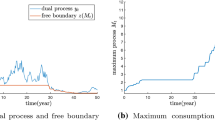Abstract
We consider a consumption-investment problem on infinite time horizon maximizing discounted expected HARA utility for a general incomplete market model. Based on dynamic programming approach we derive the relevant H–J–B equation and study the existence and uniqueness of the solution to the nonlinear partial differential equation. By using the smooth solution we construct the optimal consumption rate and portfolio strategy and then prove the verification theorems under certain general settings.
Similar content being viewed by others
References
Bensoussan, A.: Stochastic Control of Partially Observable Systems. Cambridge University Press, Cambridge (1992)
Cox, J.C., Huang, C.-F.: Optimal consumption and portfolio policies when asset prices follow a diffusion process. J. Econom. Theory 49, 33–83 (1989)
Chacko, G., Viceira, L.M.: Dynamic consumption and portfolio choice with stochastic volatility in incomplete markets. Rev. Financ. Stud. 18, 1369–1402 (2005)
Fleming, W.H., Hernandez-Hernandez, D.: An optimal consumption model with stochastic volatility. Financ. Stoch. 7, 245–262 (2003)
Fleming, W.H., Hernandez-Hernandez, D.: The tradeoff between consumption and investment in incomplete markets. Appl. Math. Optim. 52, 219–235 (2005)
Fleming, W.H., Pang, T.: An application of stochastic control theory to financial economics. SIAM J. Cont. Optim. 52, 502–531 (2004)
Hata, H., Sheu, S.J.: On the Hamilton–Jacobi–Bellman equation for an optimal consumption problem: I. Existence of Solution. SIAM J. Cont. Optim. 50, 2373–2400 (2012)
Hata, H., Sheu, S.J.: On the Hamilton–Jacobi–Bellman equation for an optimal consumption problem: II. Verification theorem. SIAM J. Cont. Optim. 50, 2401–2430 (2012)
Kaise, H., Nagai, H.: Ergodic type Bellman equations of risk-sensitive control with large parameters and their singular limits. Asymptot. Anal. 20, 279–299 (1999)
Kaise, H., Sheu, S.J.: On the structure of solutions of ergodic type bellman equation related to risk-sensitive control. Ann. Prob. 34, 284–320 (2006)
Karatzas, I., Lehoczky, J.P., Shreve, S.E.: Explicit solution of a general consumption/investment problems. Math. Oper. Res. 11, 261–294 (1986)
Liu, J.: Portfolio selection in stochastic environments. Rev. Financ. Stud. 20, 1–39 (2007)
Ladyzhenskaya, O.A., Ural’tseva, N.N.: Linear and Quasilinear Elliptic Equations. Academic Press, New York (1968)
Merton, R.C.: Optimal consumption and portfolio rules in a continuous time model. J. Econom. Theory 3, 373–413 (1971)
Nagai, H.: Ergodic control problems on the whole Euclidean space and convergence of symmetric diffusions. Forim Mathematicum 4, 159–173 (1992)
Nagai, H.: Bellman equations of risk-sensitive control. SIAM J. Control Optim. 34, 74–101 (1996)
Nagai, H.: Downside risk minimization via a large deviations approach. Ann. Appl. Prob. 22, 608–669 (2012)
Parthasarathy, K.R.: Probability Measures on Metric Spaces. AMS Chelsea Publishing, Providence (1967)
Pliska, S.R.: A stochastic calculus model of continuous trading: optimal portfolio. Math. Oper. Res. 11, 239–246 (1986)
Wachter, J.A.: Portfolio and consumption decisions under mean-reverting returns: an exact solution for complete markets. J. Financ. Quant. Anal. 37, 69–91 (2002)
Acknowledgments
The author would like to express his thanks to professor S. J. Sheu who attracted his interest to the consumption-investment problems with useful discussions about them, and also encouraged him to extend his private notes on the problems to an article to be published somewhere. Thanks are also due to the referee for his (her) careful reading of the manuscript and correcting a number of typos.
Author information
Authors and Affiliations
Corresponding author
Additional information
Supported in part by a grant-in-aid for Scientific Research 25400150, 23244015, 23340028 JSPS.
Appendices
Appendix 1
Here, we give the proof of the existence of a solution to (2.11) along the line of Hata and Sheu [7], which complete the proofs of Theorems 4.1 and 4.2. We rewrite the equation (2.11) as follows.
where
To prove the existence of a solution to (6.1), we first consider the Dirichlet problem on \(B_R\):
where \({\underline{z}}\) is a smooth sub-solution to (2.11). For \(\gamma <0\), \({\underline{z}}\) is the sub-solution appeared in Lemma 3.1 and for \(0<\gamma <1\), \({\underline{z}}=-C\) with sufficiently large \(C\). In proving the existence of a solution to (6.2) we appeal to the following theorem, a modification of the Leray-Schauder fixed point theorem, according to the scheme due to Hata and Sheu ([7]).
Theorem 6.1
(Hata and Sheu [7]) Let \({\mathcal B}\) be a Banach space with the norm \(\parallel \cdot \parallel _{{\mathcal B}}\) and \(T\) a continuous, compact operator from \({\mathcal B}\times [0,1]\) to \({\mathcal B}\). Assume that there exists a constant \(M>0\) such that \(\parallel \xi \parallel _{{\mathcal B}}<M\) for all \((\xi ,\tau )\) satisfying \(\xi =T(\xi ,\tau )\), or \(\xi =\tau T(\xi ,0)\). Then, there exists a fixed point \(\xi \in {\mathcal B}\): \(\xi = T(\xi ,1)\).
In applying this theorem, we consider the following problem for each \(\tau \in [0,1]\):
We note that, under assumptions (2.13)–(2.15), for \(x\in B_R,\; |z|\le M\), we have
where \(c_1,c_2\) and \(c_3\) are positive constants. To study (A.3), we consider the linear partial differential equation
for a given function \(w\in C^{1,\mu }({\overline{B}_R})\), \(1>\mu >0\). Under assumptions (2.13)–(2.15), we have a unique solution \(z\in C^{2,\mu \mu '}({\overline{B}_R})\) since \({\underline{z}}\in C^{2,\mu }({\overline{B}_R})\) (cf. [13]). Thus, we can define a continuous, compact mapping \(T(w,\tau )\) of \({\mathcal B}\times [0,1]\) into \({\mathcal B}\) as \(T(w,\tau )=z\), where \(z\) is the solution to (6.4) for a given function \(w\in {\mathcal B}:=C^{1,\mu }({\overline{B}_R})\) and \(\tau \in [0,1]\). Indeed, since \(b(x,w,Dw;\tau \gamma )\in C^{0,\mu }({\overline{B}_R}) \) for \(w\in C^{1,\mu }({\overline{B}_R})\), and we assume that \(\tau {\underline{z}} \in C^{2,\mu }({\overline{B}_R})\), \(T(w,\tau )\), for every \(\tau \), transforms the function \(w\in C^{1,\mu }({\overline{B}_R})\) into \(z(x;\tau )\) in \(C^{2,\mu '\mu }({\overline{B}_R})\). Further, we have
where \(f\) is a continuous monotonically increasing function of \(t\in [0,\infty )\). Since an arbitrary bounded set in \(C^{2,\mu '\mu }({\overline{B}_R})\) is compact in the space \(C^{1,\mu }({\overline{B}_R})\), \(T(w,\tau )\) maps each bounded set of the pairs \((w,\tau )\) in \(C^{1,\mu }({\overline{B}_R})\times [0,1]\) into a compact set in \(C^{1,\mu }({\overline{B}_R})\). On the other hand, when \(\parallel w_1-w_2\parallel _{C^{1,\mu }({\overline{B}_R})} \) goes to \(0\), \(\parallel b(x,w_1,Dw_1;\tau \gamma )- b(x,w_2,Dw_2;\tau \gamma )\parallel _{C^{0,\mu }({\overline{B}_R})}\) tends to \(0\) uniformly with respect to \(\tau \). Moreover, \(T(w,\tau )\) is continuous in \(\tau \) uniformly with respect to \((x, w, Dw) \in {\overline{B}_R}\times \{u\in R^n;|u|\le c\}\times \{p\in R^n; |p|\le c\}\). Therefore \(T(w,\tau )\) is a continuous map of \((w,\tau )\in C^{1,\mu }({\overline{B}_R})\times [0,1]\) into \(C^{1,\mu }({\overline{B}_R})\).
Note that a fixed point \(z^{(\tau )}\) of \(T\), \(z^{(\tau )}=T(z^{(\tau )},\tau )\), is a solution to (6.3) and \(z^{(1)}\) is a solution to (6.2). On the other hand, if we set \(z_0=T(w,0)\), then \(z_0\) satisfies
with
Therefore, \(z_0^{(\tau )}=\tau T(w;0)\) turns out to be a solution to the equation
Hence, a fixed point \({\hat{z}}_0^{\tau }=\tau T({\hat{z}}_0^{\tau };0)\) is a solution to
Now, let us give the proof of the existence of a solution to (6.1).
Step 1. Proof of the existence of a solution to (6.2).
Owing to Theorem 3.8 in Hata and Sheu [7], we have the estimate for \(z^{(\tau )}\):
where \(f_0(x)\) is the solution to
Moreover, we see that
for sufficiently large \(C>0\). Indeed, when \(\gamma <0\), for \(x\in \{x; {\underline{z}}(x)\le 0\}\) \(\tau {\underline{z}}(x)\ge {\underline{z}}(x)>-C\) for each \(\tau \in (0,1]\) since \({\underline{z}}(x)\) is bounded in \({\overline{B}_R}\). \(\tau {\underline{z}}(x)>-C\) holds as well in \(x\in \{x; {\underline{z}}(x)\le 0\}^c\). Moreover, \(-C\) becomes a sub-solution of (6.3) by taking \(C\) to be sufficiently large. Therefore we see (6.10) owing to Lemma 3.6 in [7]. Similarly, (6.10) holds also in the case of \(0<\gamma <1\).
Further, owing to Theorem 3.9 in Hata and Sheu [7], we have
where \(\sigma _R=\inf \{ t; |X_t|=R\}\), and \(X_t\) is the solution to the stochastic differential equation:
Therefore, from Theorem 4.1 and 6.1, Chapter 4 in [13], we obtain the estimates
for a positive constant \(M\) independent of \(\tau \), \(z^{(\tau )}\) and \(z_0^{(\tau )}\). Then, from Theorem 4.1 and 6.1, Chapter 4 in [13], we obtain
where the constants \(M_1\), \(M_2\) and \(\mu '\) are determined by \(n\), \(M\), \(c_1\), \(c_2\), and \(c_3\). Thus, we can consider the operator \(T(w;\tau )\) only on the space
for \(\epsilon >0\). Then, we see that there exists \({\tilde{M}}\) such that
for any fixed points \(z^{(\tau )}\) and \(z_0^{(\tau )}\). Hence, Theorem 6.1 applies and we see that \(z\in C^{2,\mu \mu '}({\overline{B}_R})\) such that \(z=T(z,1)\).
Step 2. Proof of the existence of the solution to (6.1).
Let us take a sequence \(\{R_n\}\) such that \(R_n\rightarrow \infty \), as \(n\rightarrow \infty \), and a sequence of solutions \(z_{R_n}\) to (6.2). Since \({\underline{z}}\) is a subsolution to (6.1), we can see that \(z_{R_n}\) is nondecreasing because of the maximum principle. Further, we can see that \(z_{R_n}\) is dominated by the super-solution \({\overline{z}}(x)\) again by the maximum principle. Therefore, there exists \(z(x)\) to which \(z_{R_n}\) converges as \(n\rightarrow \infty \). Note that there exists a constant \(M\) independent of \(n\) such that
for \(r<R_n\), which can be seen in a similar manner to the proof of Proposition 3.2 in [17] (cf. Appendix 2 and also (3.8)). Therefore, we can see that \(z_{R_n}\rightarrow z \), \(W^{1,p}_{loc}\) weakly \(\forall p>1\) by taking a subsequence if necessary. The convergence can be strengthen as \(\nabla z_{R_n}\) converges in \(L^2_{loc}\) strongly to \(\nabla z\). As a result we can see that \(z\in W^{1,p}_{loc}\) is a weak solution to (6.1). Then, from the regularity theorem we see that \(z\in C^{2,\mu ''}\) and that it is a classical solution to (6.1). \(\square \)
Appendix 2
Let us give the gradient estimates for the solution to H–J–B equation (2.11).
Lemma 7.1
Under assumptions(2.13)–(2.15), the solution \(z\) to (2.11) satisfies the following estimate.
for some positive constant \(C>0\).
The proof of this estimate is almost the same as the one of Proposition 3.2 in [17]. Here we only give some remarks that the proof could proceed in almost parallel to it. One could see [17] to be more precise.
Proof
Set \(Q^{ij}:=(\lambda N_{\gamma }^{-1}\lambda ^*)^{ij}\) and differentiate (2.11). Then, we have
Set \(F=|\nabla z|^2=\sum _{k=1}^n|D_kz|^2\) and
Then, we have
Here we have used (7.2) and the matrix inequality \( (\text{ tr }[AB])^2\le nC\text{ tr }[AB^2]\), for symmetric matrix \(B\) and nonnegative definite symmetric matrix A having the maximum eigenvalue \(C\). Thus, in a similar manner to the proof of Proposition 3.2 in [17] (cf. also [9, 10, 15]) we can obtain estimate (7.1) by using H–J–B equation (2.11) again in the last line in the above. Although we have the term \((1-\gamma )e^{-\frac{z}{1-\gamma }}\) in the equation it does not affect the proof since it is nonnegative. \(\square \)
Rights and permissions
About this article
Cite this article
Nagai, H. H–J–B Equations of Optimal Consumption-Investment and Verification Theorems. Appl Math Optim 71, 279–311 (2015). https://doi.org/10.1007/s00245-014-9258-0
Published:
Issue Date:
DOI: https://doi.org/10.1007/s00245-014-9258-0
Keywords
- Utility maximization
- Risk-sensitive stochastic control
- Factor models
- H–J–B equation
- Infinite time horizon




